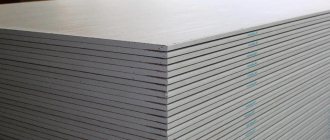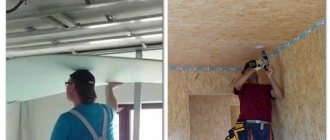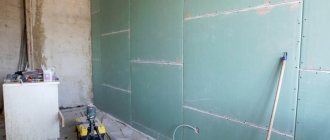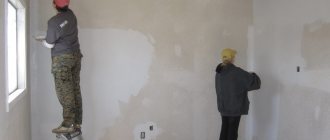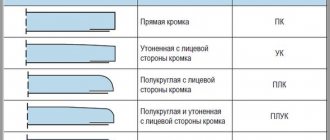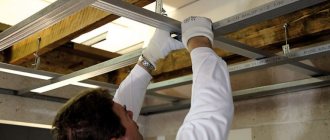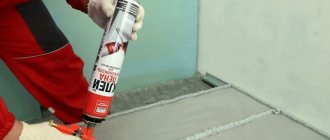When planning any repair or finishing work, you must make sure that all selected materials are environmentally friendly and will not harm human health during further use. Modern renovation today is not complete without drywall. It is used for cladding walls, creating suspended structures on the ceiling, as well as forming various functional and decorative components in the house.
At the same time, many people have the question “is drywall harmful?” We will try to answer it in this article.
Rumors and speculation
Opinions that drywall can be dangerous to human health continue to multiply and there are discussions about this between supporters and opponents of the material. Moreover, it is not always clear whether this is a dispute between real people or just “dirty games” of competitors. Of course, any building material, especially those used for interior decoration in an apartment or residential building, has its advantages and disadvantages. But the main thing is that it is not harmful to the health of people living in the premises. Therefore, if there are even slight suspicions about this, you need to thoroughly understand it in order to avoid a negative impact on the health of household members. To understand whether drywall is actually harmful, you need to understand what it consists of.
Plaster in the Apartment Harm
Attention! Having a hygiene certificate is not always a guarantee of quality. Some small manufacturers who do not care about their reputation provide false information or use permits indicating a different material or with an expired receipt.
In this regard, gypsum stands out favorably against the background of all building materials. Naturally, wood is considered the leader in this race, but gypsum deservedly takes second place in terms of environmental friendliness. For this reason, this raw material is given a worthy place in Russia among other building materials.
Composition is the key to health
The structure of the slab
Drywall is an environmentally friendly material that consists of two parts:
- two layers of cardboard;
- core made of gypsum.
If there are no complaints about the cardboard, then the composition of the core raises certain doubts among many. The core consists of building gypsum, which is a natural material. During the production process, gypsum is fired at a temperature of 1800 and ground. The core may also include:
- starch;
- fiberglass;
- PVA glue and other components.
Note! The composition of the gypsum core depends on what type of drywall needs to be made. Special additives give the material moisture-resistant and fire-resistant properties.
After making the plaster core, it is placed between two layers of cardboard. It is quite dense and therefore plays the role of reinforcement. According to the adopted GOST 8740-85, during the manufacture of plasterboard, cardboard with a density of 0.17 to 0.22 kg/m2 is used.
After attaching the cardboard to the plaster, the edges of the sheet are folded at the ends, thus forming a protective edge. It prevents damage to the sheets during transportation and storage.
The result is a truly environmentally friendly material that can be mounted on ceilings, walls, or made into various structures.
How to choose a safe material?
When purchasing, you need to consider some nuances:
- Brand. It is better to choose products from trusted companies that have the necessary documentation and labeling. At the moment, the construction market offers products of different price categories.
A trusted brand does not always act as an absolute guarantee of the quality and safety of the material; these are the brands that are most often counterfeited, so you need to carefully check the accompanying documents - Appearance. The slab should consist of three layers: two cardboard and a plaster base. The structure is completely homogeneous; the light color of the filler with possible inclusions stands out in the section.
- Smell. Strong, intrusive or unpleasant odors are unacceptable.
- Product type. The categories are distinguished by markings and colors: regular - gray, moisture-resistant - green, fire-resistant - pinkish.
As experts assure, the presence of impregnations that increase fire and water resistance does not in any way affect the level of toxicity of the material.
Also, we must not forget that drywall is a breathable material that can absorb excess moisture and release it back. This allows you to create a microclimate in the room. Special varieties do not have this feature. In addition, the process is influenced by finishing, which can reduce or eliminate this ability.
Product range
Today, plasterboard has a wide range, allowing it to be used both on the ceiling and walls in various rooms. The available range includes the following types of sheets:
- standard type. This is the most common drywall, which has standard qualities and properties. Its production not only does not use harmful substances that can harm human health - the composition of the core does not contain any special additives at all. It can be mounted on walls and ceilings in rooms with a normal microclimate;
Standard sheets
- moisture resistant type. These sheets contain special additives that impregnate the cardboard and core. In this case, waterproof mixtures and antifungal compounds are used. They protect the material from the harmful effects of excess humidity, and also prevent the appearance of fungus and mold on the walls and ceiling;
Moisture resistant sheets Fire resistant sheets
- fireproof type. Here the material includes a special fiberglass mesh that protects the stove from the negative effects of open fire. During combustion, no harmful or toxic substances are released into the air. The only exception is carbon monoxide, which is always present during a fire. This type of drywall is installed in rooms with a high fire hazard;
- fire and moisture resistant type. It has moisture-resistant and fire-resistant properties. For its production, the same additives are used as for the production of sheets with moisture-resistant and fire-resistant characteristics.
All substances used as additives to the material to give them special properties are tested for compliance with GOST, as well as safety standards. Therefore, the material does not contain harmful and toxic substances, as well as heavy metals. As you can see, drywall is completely safe to use and does not harm human health.
But despite this, in certain situations it can pose a threat to human health.
Plasterboard walls - gypsum plasterboard
A plasterboard sheet is a layer of gypsum wrapped in thick paper, measuring 1200x2500x12.5 mm and weighing 29 kg. It can also be thinner - 9 mm wide, but this option is very fragile. It is mounted as follows: first, a frame is formed from a metal profile, then plasterboard sheets are sewn onto the frame in two layers, overlapping on all sides. The final wall thickness will depend on the width of the metal profile used 50/65/75/100 and will be 100/115/125/150 mm, respectively. GCR is sheathed not only on walls, but also on ceilings.
Waterproof plasterboard sheets (GKLV) of green color are also sold, but they are conditionally waterproof: with constant exposure to water, such sheets will swell, even if they are covered with tiles on top. It is better not to use it in “wet” rooms at all.
GCR cost: 250-350 rubles/piece. GKLV will be more expensive.
Pros:
Minuses:
- 1 m² of plasterboard wall can withstand no more than 20 kg of facing material. That is, the tiles will withstand normally, but porcelain tiles are no longer a fact. If overloaded, the finish will soon fall off along with a layer of cardboard, exposing the plaster.
- One butterfly dowel (the tip of which opens after screwing) will hold an object weighing no more than 10 kg in a plasterboard wall, and no more than 4 kg on the ceiling (you will have to make a cutout under the curtain rod or lay a beam on the ceiling). If you want to hang something heavier, you need to know in advance where exactly and lay a beam or profile there.
- Very poor sound insulation.
- Low strength - dents remain from impacts.
- Use with great care in damp areas.
When is it harmful?
Despite the environmental friendliness of the additives, as well as full compliance with GOST, drywall can still cause a deterioration in people’s well-being and health. The main reason that can lead to such a negative impact on humans is violations of storage and use conditions. Therefore, before buying drywall, you need to carefully read its characteristics, properties, as well as storage and use conditions. There are certain pitfalls here that you definitely need to be aware of if you plan to use drywall. Let's consider situations where such an environmentally friendly material can harm the human body:
Drilling sheets
- cutting sheets or drilling them releases dust into the air, which settles on the respiratory system. This type of work poses the greatest danger to people who are allergic to household dust. In addition, systematic work with the material leads to the fact that dust often settles on the mucous membranes and can subsequently provoke the appearance of various respiratory diseases;
Note! To neutralize the negative impact of dust, you need to wear protective goggles over your eyes and a bandage over your nose and mouth during the work described above.
- When standard sheets that are used in an unsuitable microclimate are excessively moistened, they become an excellent environment for the development of mold fungi.
This is the most commonly encountered situation (after dust) when drywall can have a negative impact on people's health. Exposure to mycotoxins floating in the air leads to the development of allergies in people, and also, to a certain extent, reduce the body’s protective properties through suppression of the immune system.
Note! You can avoid the development of fungi on drywall by properly installing it and treating it with fungicides.
- purchasing uncertified and cheaper material made in China. Such sheets may contain phenolic compounds and formaldehydes, which can have a very negative effect on humans, even causing poisoning. Certificate of quality for drywall
As you can see, the material itself is absolutely safe to use. And in order to minimize its potential negative impact on the body, you need to follow the appropriate recommendations.
Recommendations for work
When planning renovation finishing work using plasterboard sheets, follow the tips below and your health will not be in danger. The list of recommendations is as follows:
- the core of the sheets should be as close to white as possible. Colors such as pink and gray indicate low quality gypsum;
- the core should be uniform and not peel off from the cardboard;
- There should be no swelling or damage on the cardboard. Its layer should be uniform;
- choose the right type of sheets based on their properties;
- choose the material based on the type of work: for the ceiling, walls, arches, etc.;
- buy material only if it has a quality certificate;
- store the sheets correctly, giving them time to acclimatize to the microclimate of the room;
- follow the correct installation technology;
- Wear eye, mouth and nose protection when working with drywall.
Carefully read the above information, and you will be able to easily select the material you need, as well as prevent its possible negative impact on your body.
Correct installation of hatches for plasterboard boxes
Correctly getting rid of cracks in a plasterboard ceiling
Violation of production technology
Sometimes a manufacturer tries to save on raw materials and violates production technology by using cheap, untested additives containing phenols and formaldehydes.
To avoid accidentally purchasing toxic gypsum plasterboard, it is better to purchase products from well-known and trusted manufacturers and demand to see a quality certificate. When purchasing, you should pay attention to the following signs of material quality:
- plaster should be snow-white;
- have a uniform structure, without dust and large inclusions;
- the filler should not crumble or crumble;
- the surface of the cardboard is smooth, without bulges or dips;
- The thickness of the cardboard should be the same along the entire length.
